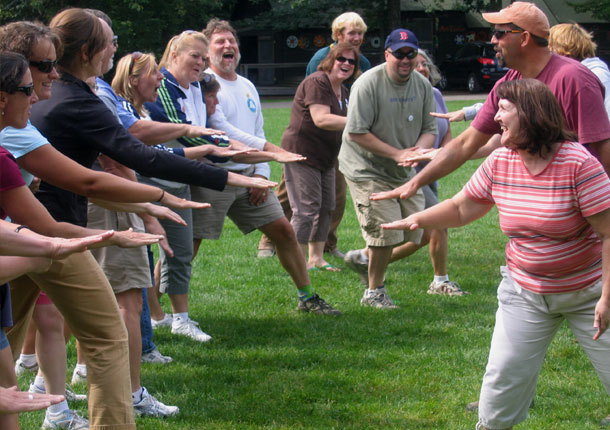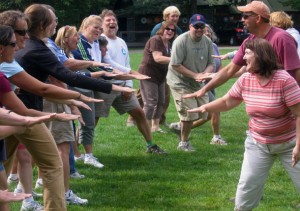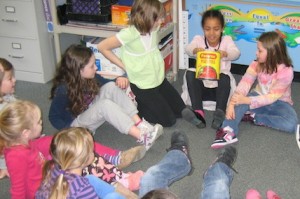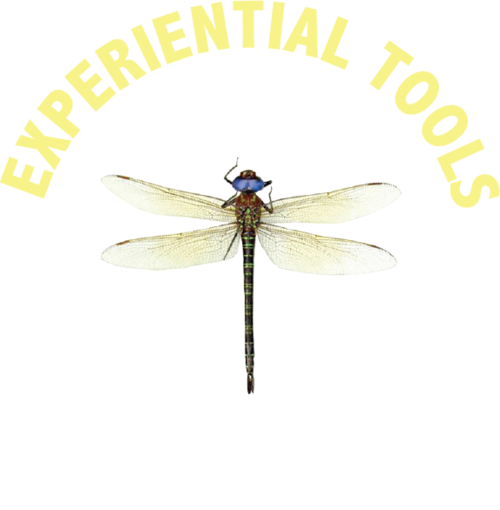
Mar 13, 2013 Harnessing the Power of Play to Teach
To be playful and serious at the same time defines the ideal mental condition. John Dewey
Play, Brain Research and 21st Century Learning
We learn some of our most basic life skills through play. Play contributes to the development of one of our most important brain functions- the ability to control and modify our behavior in order to reach a goal. Adults, adolescents and children all learn and can potentially “change their brains” through play (Aamodt and Wang, 2011).
 Research from the emerging field of educational neuroscience is suggesting that interactive social play improves executive function. Executive function is the term used by neuroscientists to describe cognitive processes that regulate, manage and control other cognitive functions such as attention, problem-solving, working memory, reasoning, inhibition, and evaluating and controlling ones actions. These are the skills that promote success in school, personal life, and work.
Research from the emerging field of educational neuroscience is suggesting that interactive social play improves executive function. Executive function is the term used by neuroscientists to describe cognitive processes that regulate, manage and control other cognitive functions such as attention, problem-solving, working memory, reasoning, inhibition, and evaluating and controlling ones actions. These are the skills that promote success in school, personal life, and work.
Qualities such as these are emphasized in social-emotional learning and 21st century skills development programs. Poor executive function is associated with high drop out rates, drug use and crime. Good executive function is a better predictor of success in school and later in professional life than a child’s IQ (Diamond, 2010).
Developing and Reinforcing Positive Behaviors:
Play helps people learn and practice executive functions such as self-regulation and impulse control. Rules and boundaries are necessary for play to be successful. Kids learn self-regulation from practicing taking turns, and focusing on the different tasks necessary to participate in a game. Playing safely, staying within boundaries, following rules, and other regulatory skills are necessary for, and practiced through play.
 Studies find structured and unstructured interactive play is a powerful way to improve these executive functions in children and adults because many of the cognitive processes involved have plasticity and can be developed through practice. Use of these skills or mental capacities builds up that ability. Play, especially play that involves problem-solving tasks, social interaction, planning, reasoning, and multiple senses, encourages this kind of mental growth and self-regulation skills (Aamodt and Wang, 2011).
Studies find structured and unstructured interactive play is a powerful way to improve these executive functions in children and adults because many of the cognitive processes involved have plasticity and can be developed through practice. Use of these skills or mental capacities builds up that ability. Play, especially play that involves problem-solving tasks, social interaction, planning, reasoning, and multiple senses, encourages this kind of mental growth and self-regulation skills (Aamodt and Wang, 2011).
Studies on brain structure and chemistry also show that both high levels of attention and lower levels of the stress hormone cortisol are associated with play. Play activates norepinephrine, which arouses attention and can improve brain plasticity in some neurons (Aamodt and Wang, 2011, Willis, 2010). In play situations this attention rousing system is activated without releasing cortisol or stress hormone (as it is in emergency/survival situations). A high and sustained level of the stress hormone cortisol is associated with inhibiting brain function and growth. Playful learning promotes inclusion, and play inherently involves opportunities for adaptation and creativity. A playful approach facilitates learning by arousing attention without the potentially damaging stress response in the brain.
 Play and Dopamine: Dopamine is an essential neurotransmitter involved in awareness, attention and mood. Dopamine levels are associated with the reward center of the brain, and the heightened sense of pleasure that characterizes rewarding experiences. When we experience something pleasurable, our dopamine levels increase. Engaging students in learning activities that correlate with increased dopamine release will likely get them to respond not only with pleasure, but also with increased focus, memory and motivation (Willis, 2010).
Play and Dopamine: Dopamine is an essential neurotransmitter involved in awareness, attention and mood. Dopamine levels are associated with the reward center of the brain, and the heightened sense of pleasure that characterizes rewarding experiences. When we experience something pleasurable, our dopamine levels increase. Engaging students in learning activities that correlate with increased dopamine release will likely get them to respond not only with pleasure, but also with increased focus, memory and motivation (Willis, 2010).
Multiple pathways to learning: Playful approaches to teaching engage learners socially, emotionally, physically as well as intellectually. These activities involve multiple senses and can create multiple neuronal pathways to learning. Educational neuroscientists emphasize that the more ways in which something is learned and practiced, the easier it is to recall and access that information. (Willis, 2006, Medina, 2008)
The benefits of a playful approach to teaching and skills building:
- Brains need a break from focused attention like that experienced in a lecture or direct instruction. Play with a purpose can be a vehicle for giving learners “brain breaks” while still making the most of classroom time.
- Play promotes and supports positive behaviors. Play helps people learn and practice executive functions such as self-regulation and impulse control. Rules and boundaries are necessary for play to be successful. Because play is desirable people will be motivated to practice rules of self-regulation in ways they might not in every day life.
- Children and adolescents learn self-regulation from practicing taking turns and focusing on the different tasks necessary to a game. Playing safely, staying within boundaries and other regulatory skills are necessary to play and practiced in the activities presented here.
- In some neurons, norepinephrine is released in play situations and attention is increased. This chemical improves brain plasticity. Change and growth becomes possible when this chemical is present in elevated amounts.
- Play brings joy to learning. Joy being defined as “the emotion of great delight or pleasure caused by something good or satisfying”. Joyful learning releases dopamine.
- Engaging participants in learning activities that correlate with increased dopamine release are associated with positive/pleasurable associations with learning in addition to increased attention, focus and retention of information. When there is a positive association to learning material people are more likely to remember it and want to keep pursuing their learning.
- Play involves movement and uses multiple senses. Movement is associated with increased attention and retention. Multiple ways of practicing and reinforcing information including through games increases neuronal pathways leading to stronger memories and recall ability.
- Play promotes inclusion, and play inherently involves opportunities for adaptation and creativity. I find that playful activities are a great tool for bringing all learners of various abilities together in the classroom.
- Play reduces stress (play has been shown to reduce cortisol levels and is associated with increased dopamine levels).
- Play helps people practice receptive and expressive, non-verbal and verbal communication skills.
- Play symbolizes the real world; modeling and practicing common social interactions, helping learners practice language communication, problem solving, logical thinking, predict and express preferences, master ideas and abstract themes.
References:
Diamond, A. (2010). The evidence base for improving school outcomes by addressing the whole child and by addressing skills and attitudes, not just content. Early Education and Development, 21, 780-793.
Medina, John. (2008). Brain Rules: 12 Principles for Surviving and Thriving at Work, Home and School. Seattle, WA: Pear Press.
Ratey, John. (2008). Spark: The Revolutionary New Science of Exercise and the Brain. New York: Little Brown and Company.
Willis, Judy. (2006). Research-Based Strategies to Ignite Student Learning. Alexandria, VA: ASCD.
Willis, Judy (2010) ASCD Edge “Want Children to Pay Attention? Make Their Brain’s Curious.www.radteach.com (Judy Willis’ website)
Wang, Sam and Aamodt, Sandra.(2008) Welcome to Your Brain. New York: Bloomsbury Publishing.
Wang, Sam & Aamodt, Sandra. (2011) Welcome to Your Child’s Brain. New York: Bloomsbury Publishing.



No Comments